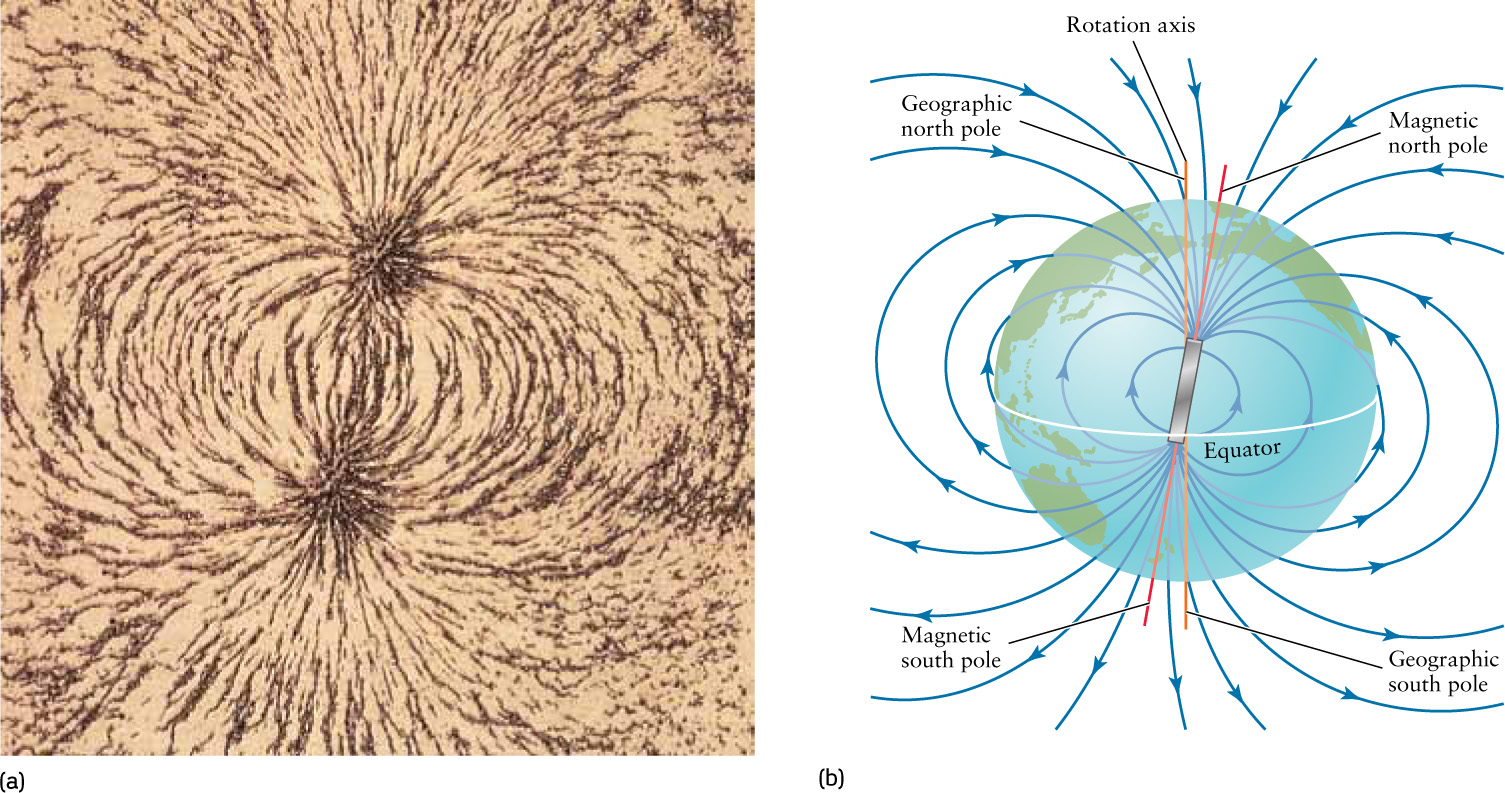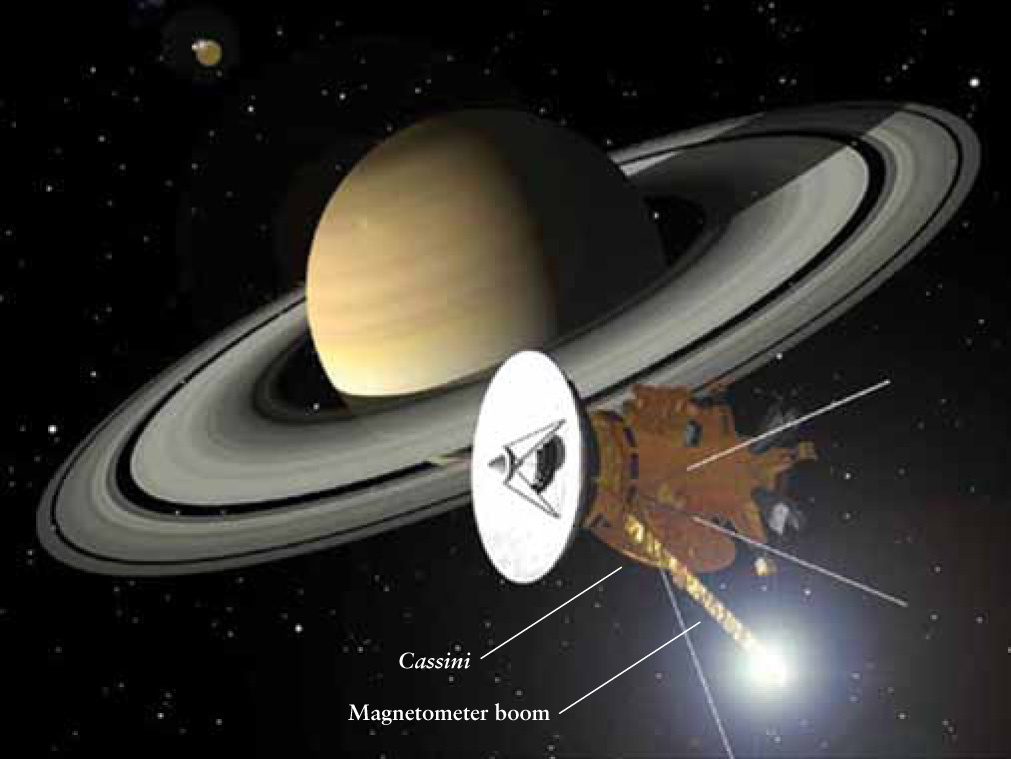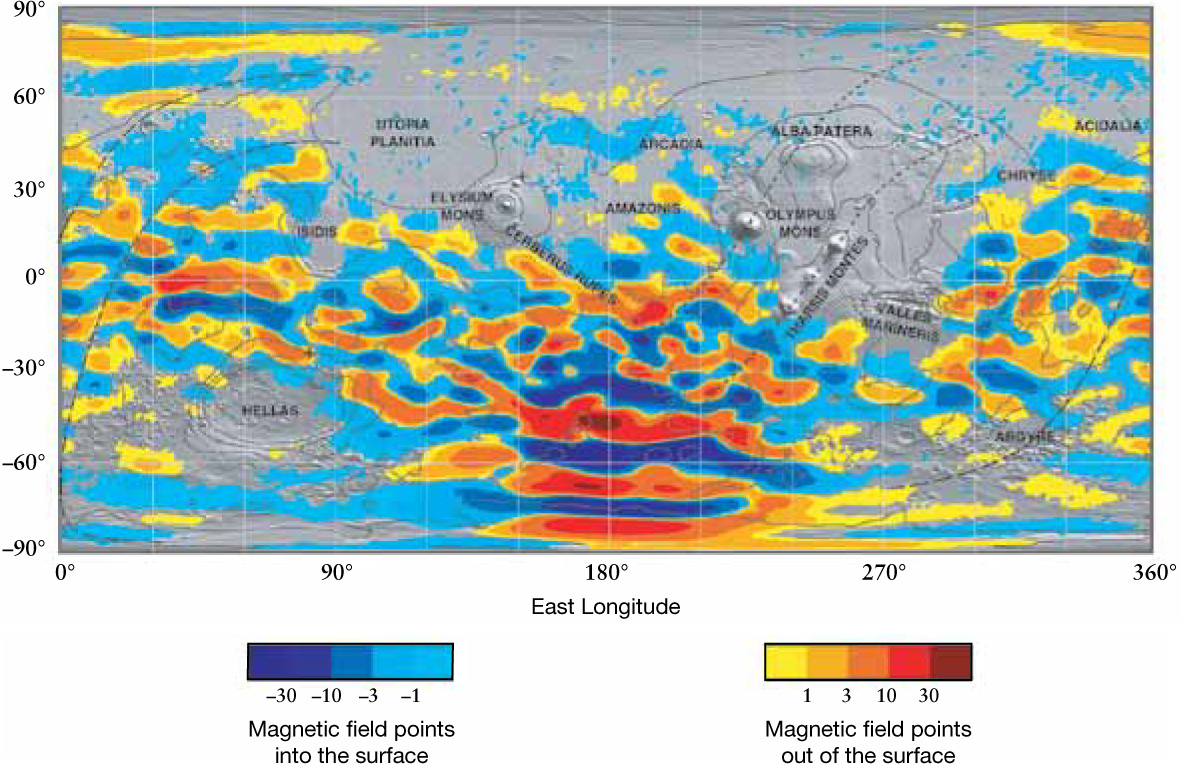7-7 A planet with a magnetic field indicates a fluid interior in motion
By studying the magnetic field of a planet or satellite, scientists can learn about that world’s interior
The amount of impact cratering on a terrestrial planet or satellite provides indirect evidence about whether the planet or satellite has a molten interior. But another, more direct tool for probing the interior of any planet or satellite is an ordinary compass, which senses the magnetic field outside the planet or satellite. Magnetic field measurements prove to be an extremely powerful way to investigate the internal structure of a world without having to actually dig into its interior. To illustrate how this works, consider the behavior of a compass on Earth.
The needle of a compass on Earth points north because it aligns with Earth’s magnetic field. Such magnetic fields arise whenever electrically charged particles are in motion. For example, a loop of wire carrying an electric current generates a magnetic field in the space around it. The source of the magnetic field that surrounds an ordinary bar magnet (Figure 7-13a) is complicated, but part of it is created by the motion of negatively charged electrons within the iron atoms of which the magnet is made. Earth’s magnetic field is similar to that of a bar magnet, as Figure 7-13b shows. The consensus among geologists is that this magnetic field is caused by the motion of the liquid portions of Earth’s interior. Because this molten material (mostly iron) conducts electricity, these motions give rise to electric currents, which in turn produce Earth’s magnetic field. Our planet’s rotation helps to sustain these motions and hence the magnetic field. This process for producing a magnetic field is called a dynamo.

CAUTION!
While Earth’s magnetic field is similar to that of a giant bar magnet, you should not take this picture too literally. Earth is not simply a magnetized ball of iron. In an iron bar magnet, the electrons of different atoms orbit their nuclei in the same general direction, so that the magnetic fields generated by individual atoms add together to form a single, strong field. But at temperatures above 770°C (1418°F = 1043 K), the orientations of the electron orbits become randomized. The fields of individual atoms tend to cancel each other out, and the iron loses its magnetism. Geological evidence shows that almost all of Earth’s interior is hotter than 770°C, so the iron there cannot be extensively magnetized. The correct picture is that Earth acts as a dynamo: The liquid iron carries electric currents, and these currents create Earth’s magnetic field.
If a planet or satellite has a mostly solid interior, then the dynamo mechanism cannot work: Material in the interior cannot flow, there are no electric currents, and the planet or satellite does not generate a magnetic field. One example of this is the Moon. As we saw in Section 7-6, the extensive cratering of the lunar surface indicates that the Moon has no geologic activity and must therefore have a mostly solid interior. Measurements made during the Apollo missions, in which 12 humans visited the lunar surface between 1969 and 1972, showed that the present-day Moon indeed has no global magnetic field. However, careful magnetic measurements of lunar rocks returned by the Apollo astronauts indicate that the Moon did have a weak magnetic field when the rocks solidified. These rocks, like the rest of the lunar surface, are very old. Hence, in the distant past the Moon may have had a small amount of molten iron in its interior that acted as a dynamo. This material presumably solidified at least partially as the Moon cooled, so that the lunar magnetic field disappeared.
We have now identified another general rule about planets and satellites:
A planet or satellite with a global magnetic field has liquid material in its interior that conducts electricity and is in motion, generating the magnetic field.
Thus, by studying the magnetic field of a planet or satellite, we can learn about that world’s interior. So, many spacecraft carry devices called magnetometers to measure magnetic fields. Magnetometers are often placed on a long boom extending outward from the body of the spacecraft (Figure 7-14). The boom isolates them from the magnetic fields produced by electric currents in the spacecraft’s own circuitry.

Measurements made with magnetometers on spacecraft have led to a number of striking discoveries. For example, it has been found that Mercury has a planetwide magnetic field like Earth’s, although it’s only about 1% as strong as Earth’s field. If Mercury’s magnetic field was simply due to a magnetized crust, variations in the field due to crust-altering craters would have been detected, yet no such variations were observed. Instead, Mercury’s smooth magnetic field—created beneath the surface—suggests that at least some of the planet’s interior is in a liquid state to act as a magnetic dynamo. A liquid interior is quite surprising because Mercury’s heavily cratered surface indicates a lack of geologic activity, which is usually associated with a solid interior. By contrast, Venus has no measurable planetwide magnetic field, even though the paucity of craters on its surface indicates the presence of geologic activity and hence a hot interior of the planet. One possible reason for the lack of a magnetic field on Venus is that the planet turns on its axis very slowly, taking 243 days for a complete rotation. Because of this slow rotation, the fluid material within the planet is hardly agitated at all, and so may not move in the fashion that generates a magnetic field.
Mars has a very interesting magnetic field that sheds light on its early history. The magnetometer aboard the Mars Global Surveyor spacecraft, which went into orbit around Mars in 1997, found that most of the planet’s crust is magnetized (Figure 7-15): Mars has no planetwide magnetic field like Earth, but portions of its rocky surface are magnetized. This information actually tells us a lot about the Martian past. During the planet’s first billion years or so, the interior was still hot and molten. Electric currents in the flowing molten material could then produce a planetwide magnetic field. As surface material cooled and solidified, the crust became magnetized by the planetwide field, and remained magnetized even after the internally generated planetwide field shut down.

The alternating stripes of magnetism on the Martian crust—seen most clearly in red and blue in the middle of Figure 7-15—tell us even more about the Martian past. Far from being “alien” features, these familiar stripes have been heavily studied in the places they occur on Earth, where they result from plate tectonics. Plate tectonics—the motion of rocky plates over a planet’s surface—are driven by a planet’s internal heat. Furthermore, on Earth plate tectonics stabilizes our atmosphere; Mars may have lost its atmosphere after its interior cooled too much to power further plate motion.
The most intense planetary magnetic field in the solar system is that of Jupiter: At the tops of Jupiter’s clouds, the magnetic field is about 14 times stronger than the field at Earth’s surface. It is thought that Jupiter’s field, like Earth’s, is produced by a dynamo acting deep within the planet’s interior. Unlike Earth, however, Jupiter is composed primarily of hydrogen and helium, not substances like iron that conduct electricity. How, then, can Jupiter have a dynamo that generates such strong magnetic fields?
To answer this question, recall from Section 5-8 that a hydrogen atom consists of a single proton orbited by a single electron. Deep inside Jupiter, the pressure is so great and hydrogen atoms are squeezed so close together that electrons can hop from one atom to another. This hopping motion creates an electric current, just as the ordered movement of electrons in the copper wires of a flashlight constitutes an electric current. In other words, the highly compressed hydrogen deep inside Jupiter behaves like an electrically conducting metal; thus, it is called liquid metallic hydrogen.
Laboratory experiments show that hydrogen becomes a liquid metal when the pressure is more than about 1.4 million times ordinary atmospheric pressure on Earth. Recent calculations suggest that this transition occurs about 7000 km below Jupiter’s cloudtops. Most of the planet’s enormous bulk lies below this level, so there is a tremendous amount of liquid metallic hydrogen within Jupiter. Since Jupiter rotates rapidly—a “day” on Jupiter is just less than 10 hours long—this liquid metal moves rapidly, generating the planet’s powerful magnetic field. Saturn also has a magnetic field produced by dynamo action in liquid metallic hydrogen. (The field is weaker than Jupiter’s because Saturn is a smaller planet with less internal pressure, so there is less of the liquid metal available.)
Uranus and Neptune also have magnetic fields, but they cannot be produced in the same way: Because these planets are relatively small, the internal pressure is not great enough to turn liquid hydrogen into a metal. Instead, it is thought that both Uranus and Neptune have large amounts of liquid water in their interiors and that this water has molecules of ammonia and other substances dissolved in it. (The fluid used for washing windows has a similar chemical composition.) Under the pressures found in this interior water, the dissolved molecules lose one or more electrons and become electrically charged (that is, they become ionized; see Section 5-8). Water is a good conductor of electricity when it has such electrically charged molecules dissolved in it, and electric currents in this fluid would be the source of the magnetic fields of Uranus and Neptune. However, there is no direct evidence of currents in liquid water for these planets, and an alternative model proposes an electrically conductive mixture of hydrogen and rocky material.
CONCEPT CHECK 7-12
By comparing parts (a) and (b) of Figure 7-13, can you conclude that there is a large bar magnet inside Earth?
No. Figure 7-13a shows the field created by a bar magnet. Figure 7-13b shows that these fields are similar in structure, but the source of the magnetic field is not a bar magnet. Instead, Earth’s magnetic field is due to electric currents flowing in a molten iron interior.
CONCEPT CHECK 7-13
Does every planet with a molten interior produce a magnetic field? Do any of the Jovian planets create their magnetic fields through electrically conductive molten iron?
The answer to both questions is no. Based on its similar size to Earth, Venus probably has a molten interior. However, it exhibits no magnetic field, probably due to its very slow rotation: Earth rotates about 243 times for each single rotation of Venus. As in the cases of Jupiter, Saturn, Uranus, and Neptune, some electrically conducting material other than iron is needed to explain the observed magnetic fields.